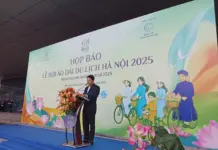It’s a no-brainer that development is critical, but the 800-pound gorilla in the room is the lack of tangible plans leading to harmony between economic expansion and environmental preservation, both here in Vietnam and around the globe.
The world is in such a climate pickle that representatives of the 40 worst-offending countries recently huddled for two days to wrap their arms around the issue. It seems every country knows the solution, but almost none are able to convert strategies into plans, then put them in motion.
Let’s check in with a couple of foreigners sitting in a café in Vietnam:
Fred: “Geez, development in Vietnam is spiraling out of control – buildings and resorts sprouting up like weeds, traffic insane.’
Mary: “They’re ruining this beautiful paradise!”
Fred: “Yep, reminds me of (insert country name here), it was great in the good old days.”
Mary: “You’d think they would have learned the lesson.”
Fred: “Yep, well, hopefully they will before it’s too late.”
Mary: “At least the coffee is served in real cups instead of enough plastic to sink a ship.”
Fred: “That’s a start. Every journey begins with the first step.”
We’re all prone to such sentimentality, blubbering over our cherished memories, lamenting the cost of progress.
A bunch of us school chums from my hometown in Canada still rehash old times decades later, mourning the demise of the local billiard joint, main hangout, and sacred site of our misspent youths.
I don’t even want to go back to the center of Ho Chi Minh City any more, preferring the sweet memory of the charm it held thirty years ago when it held such mystique!
For a foreigner from a developed country, it was like a trip backward through time – people strolling, in rickshaws or on bicycles, colonial-style buildings lining the streets, little kids sneaking a peek at the afternoon ‘thé dansant,’ or tea and a tango dance, at The Continental Hotel, oh how those were magic times!
That’s precisely what drew many trailblazing types to Vietnam in the first place, and as others joined, exponential growth followed, there’s no way to avoid it.
Here’s a couple of young Vietnamese having a chat about how the progress impacts their lives. We find them on Phu Quoc, a hub of recent development, including the recently opened Phu Quoc United Center, a humungous resort covering over 1,000 hectares in the northern part of the island.
Vinh: “Yikes, they’re planning ANOTHER mega resort!”
Phuong: “Not only is Phu Quoc popular with Vietnamese, but foreigners have been coming in droves in recent years.”
Vinh: “Yep, there sure is something alluring about an exotic island in Southeast Asia. The new airport and 30-day free visit pass have been a shot in the arm as well.”
Phuong: “Hopefully we can snag good gigs in one of the resorts.”
Vinh: “Working in the nuoc mam [fish sauce] factory is better than nothing, but there’s not much future in it.”
Phuong: “Cut it out! Stinky work – skin, clothes, hair ewwww.”
Vinh: “Not to mention making only 5 mill a month [VND5 million per month, about US$217, slightly below average in Vietnam].”
Phuong: “Those tourism and hospitality degrees we’re working on could be just the ticket to get us out of the fish sauce business and into something with a bright future.”
The Phu Quoc United Center has over 12,000 hotel rooms, features pastel-colored buildings, 24-hour street markets, a golf course, conference facilities, the Vinpearl Land Amusement Park. (I swear I’ll go bananas if they name one more thing ‘Vin’-something.)
Then we’ve got the Casino Corona, which locals earning a minimum of VND10 million – roughly $435 per month – can enjoy as well, plus shopping, entertainment, and a few bells and whistles I’ve no doubt missed, all this billing itself as a ‘Sleepless City.’
It echos Macau, Las Vegas, Disney World, Disneyland, Universal Studios resorts scattered around the globe, and countless other local ventures of the same ilk.
Hell, if I was a developer, I’d have fallen over myself to bankroll the Phu Quoc United Center and begin development.
It’s an absolute winner, what locals and international visitors want. We can imagine the squeals of bliss from mainland visitors and foreign tourists:
“Double down on that ace!”
“Gin and tonic on the rocks, twist of lemon!”
“Mot, hai, ba, DZO!”
“Double down on that double down, we’ll shoot the works!”
“Let’s hit the amusement park and that Kamikaze ride next!”
“How about that slick new steak place?”
“Big yum bro, they’ve got imported Angus beef!”
The Phu Quoc United Center is a 21st-century version of old European charm – think of Amalfi coast or Portofino in Italy. Parts of it look like Venice of yore, before the sheer weight of us all stomping around St. Mark’s Square sank it under a meter or two of water every time the rains come.
Well-traveled foreigners may not be overly impressed, but for the average Vietnamese, the Phu Quoc United Center is a dream come true – a simulated trip to Europe with every imaginable distraction at a fraction of the cost and time.
What else could a visitor possibly want except an impromptu set by Drake and Den Vau, a Vietnamese rapper?
Phu Quoc National Park, located in the northern part of the island, consists of over 31,000 hectares, of which over 8,000 are strictly protected. That’s nearly seven times larger than the Phu Quoc United Center, with the remainder of the park designated as forest rehabilitation areas.
The island is definitely building up, but it’ll be a very long time before it’s even slightly congested, it’s just different from how it was.
Thailand’s Phuket is almost identical in size, yet drew double the number of domestic and international visitors the year before last. So there’s ample room for expansion without smothering the island.
Swanky, state-of-the-art sustainable resorts are the flavor of the day in this part of the world with Bali, The Maldives, and El Nido in the Philippines boasting some beauties, along with some notable examples here in Vietnam including right on Phu Quoc.
Two well-heeled tourists lounge around the eco-friendly swimming pool on one of those remote islands, sipping drinks from coconut gourds whilst soaking up the sun:
Jane: “Wow, this is the bee’s knees!”
Sam: “Sure is babe, I wonder what the poor people are doing now.”
Jane: “It’s pretty good, $220 per night but we have the satisfaction of spending our money at a place that generates a positive carbon footprint.”
Sam: “Rough without any air-conditioning, it’s 33 degrees today, plus the shower is nippy on days when the solar panels don’t kick in.”
Jane: “Harnessing climate change is important but next time we’ll try a neighboring country – a champagne vacation for beer money.”
Sam: “If we’re feeling flush, Bhutan is the poster child for sustainability, but that comes with an even heavier price tag for tourists.”
But it’s going to require time before economies of scale kick in, rendering sustainability affordable for all.
To illustrate how far out of reach such world-class sustainable resorts are for most locals and low-end international tourists, the average Vietnamese worker would need to work and save every penny for seven months in order to pay for one week at that resort.
Those enjoying higher salaries of, say, VND15 million ($650 per month, the low end of the middle and upper classes in Vietnam) would have to work over two months to enjoy those digs for a week.
Easy to see that if the big developers could bankroll such resorts, very few locals could afford to stay in them, with low-budget foreign visitors also left out.
The alternatives are hardly enticing: riding three to a motorbike and working in fish sauce factories so the island remains perfectly natural? Building a bunch of cheap, cardboard cutout ugly skyscrapers and indoor malls?
Even worse, how about an onslaught of global big brand package resorts that detract from local look and feel? They’re hideous, an oasis designed to separate visitors from local life and culture.
Per capita gross domestic product is a paltry $3,000 per year in this country, so it’s easy to see that priority must continue to be placed on economic progress for the local population here in Vietnam.
So what’s it going to be, anchovies or Angus beef?
The choice is obvious – or is it?



